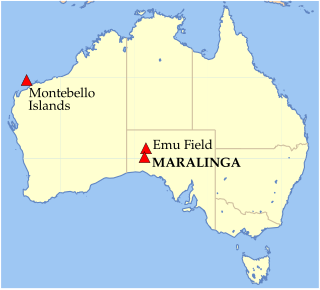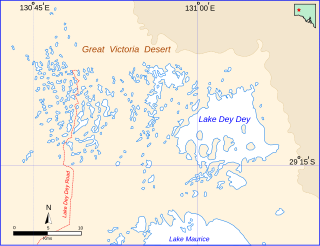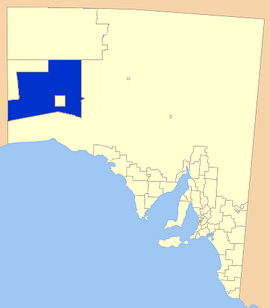Ooldea or Yuldi/Yutulynga/Yooldool (the place of abundant water) sits on a permanent underground aquifer . The area is thought to have been originally part of Wirangu land, lying on its northern border, though it fell within the boundaries of a Kokatha emu totem group. It served several Aboriginal peoples, furnishing them with a ceremonial site, trade node and meeting place for other groups, from the northeast who would travel several hundred miles to visit kin. Among the peoples who congregated there were tribes from the Kokatha and Ngalea northern groups and Wirangu of south-east and Mirning south-west. By the time Daisy Bates (1919–1935) took up residence there it was thought that earlier groups had disappeared, replaced by an influx of spinifex people from the north. By her time, the Trans-Australian Railway route had just been completed, coinciding with a drought that drew the Western desert peoples to the depot at Ooldea.
Beginning in the 1890s, there was a gradual encroachment by pastoralists up to the southern periphery of the Nullarbor Plain, but the lack of adequate water to sustain stock maintained the region relatively intact from intense exploitation. In 1933 the United Aborigines Missions established itself there, drawing substantial numbers of desert folk to the site for food and clothing, and four years later, the government established a 2,000-square-mile (5,200 km2) reserve. In 1941, the anthropologists Ronald and Catherine Berndt spent several months in the Aboriginal camp at the water soak and mission, and in the following three-year period (1942–1945) wrote one of the first scientific ethnographies of an Australian tribal group, based on his interviews in a community of some 700 desert people. Traditional life still continued since Ooldea lay on the fringe of the desert, and incoming Aboriginal people could return to their old hunting style.
Nuclear testing, dispossession and return
When the Australian Government decided in the early 1950s to set aside the Emu Field and Maralinga in the area for British nuclear testing, the community at Ooldea was forcibly removed from the land and resettled further south at Yalata, in 1952. Road blocks and soldiers barred any return.
Yalata, bordering on the Nullarbor Plain offered a totally different ecological environment; in place of the spinifex plains to the north, the Maralinga Tjaruta people found an arid stone plain, with poor thin soil and a powdery limestone that kicked up a grey dust when disturbed. Their word for "grey", namely tjilpi also signified the greying elders of a tribe, and the Aboriginal residents of Yalata called the new area parna tjilpi, the "grey earth/ground", suggesting that their forced relocation to Yalata went concomitantly with ageing towards death.
Between 1956 and 1957, seven atomic bombs were exploded on Maralinga land. In further minor trials from 1957 to 1962, plutonium was dispersed widely over much of the area. Compensation in 1993 of A$13.5 million was determined after three elders flew to London and presented samples of the contaminated soil in London in October 1991.
In 1962, the long-serving Premier of South Australia, Sir Thomas Playford, made a promise that their traditional lands would be restored to the people displaced at Yalata sometime in the future. Under the administration of his successor Frank Walsh, short two-week long bush trips were permitted, enabling them to re-connect with their traditional lifestyles. As negotiations got underway in the 1980s, the Indigenous peoples started setting up outstations near their original lands. With the passage of the Maralinga Tjarutja Land Rights Act 1984 under Premier John Bannon's government, the Maralinga Tjarutja secured freehold title in 1984, and the right to developmental funds from the State and Federal governments. They completed a move back into the area, to a new community called Oak Valley in March 1985.
Under an agreement between the governments of the United Kingdom and Australia in 1995, efforts were made to clean up the Maralinga site, being completed in 1995. Tonnes of soil and debris contaminated with plutonium and uranium were buried in two trenches about 16 metres (52 ft) deep. [19] The effectiveness of the cleanup has been disputed on a number of occasions. [20] [21]
In 2003 South Australian Premier Mike Rann opened a new school costing A$2,000,000 at Oak Valley. The new school replaced two caravans with no running water or air-conditioning, a facility that had been described as the "worst school in Australia".
In May 2004, following the passage of special legislation, Rann fulfilled a pledge he had made to Maralinga leader Archie Barton as Aboriginal Affairs Minister in 1991, by handing back title to 21,000 square kilometres (8,100 sq mi) of land to the Maralinga Tjarutja and Pila Nguru people. The land, 1,000 kilometres (620 mi) north-west of Adelaide and abutting the Western Australia border, is now known as Mamungari Conservation Park. It includes the Serpentine Lakes and was the largest land return since Premier John Bannon's hand over of Maralinga lands in 1984. The returned lands included the sacred Ooldea area, which also included the site of Daisy Bates' mission camp. [24]
In 2014, the last part of the land remaining in the Woomera Prohibited Area, known as "Section 400", was excised and returned to free access. [25]
Maralinga Tjarutja Council
The Maralinga Tjarutja Council is an incorporated body constituted by the traditional Yalata and Maralinga owners to administer the lands granted to them under the Maralinga Tjarutja Land Rights Act 1984 (SA). The head office is in Ceduna.
The Maralinga Tjarutja and the Pila Nguru (or Spinifex people) also jointly own and administer the 21,357.85-square-kilometre (8,246.31 sq mi) Mamungari Conservation Park, which area is contained in the area total for the council area. Emu Field is now part of the council area, too, while the 3,300-square-kilometre (1,300 sq mi) Maralinga area is still a roughly square-shaped enclave within the council area.
The land surveyed and known as Section 400, 120 km2 (46 sq mi) within the Taranaki Plumes, was returned to Traditional Ownership in 2007. This land includes the area of land occupied by the Maralinga Township and the areas in which atomic tests were carried out by the British and Australian governments.
The final part of the 1,782 km2 (688 sq mi) former nuclear test site was returned in 2014.
Local government in the Australian state of South Australia describes the organisations and processes by which towns and districts can manage their own affairs to the extent permitted by section 64A of Constitution Act 1934 (SA).
Native title is the designation given to the common law doctrine of Aboriginal title in Australia, which is the recognition by Australian law that Indigenous Australians have rights and interests to their land that derive from their traditional laws and customs. The concept recognises that in certain cases there was and is a continued beneficial legal interest in land held by Indigenous peoples which survived the acquisition of radical title to the land by the Crown at the time of sovereignty. Native title can co-exist with non-Aboriginal proprietary rights and in some cases different Aboriginal groups can exercise their native title over the same land.

Maralinga, in the remote western areas of South Australia, was the site, measuring about 3,300 square kilometres (1,300 sq mi) in area, of British nuclear tests in the mid-1950s.

Between 1956 and 1963, the United Kingdom conducted seven nuclear tests at the Maralinga site in South Australia, part of the Woomera Prohibited Area about 800 kilometres (500 mi) north west of Adelaide. Two major test series were conducted: Operation Buffalo in 1956 and Operation Antler the following year. Approximate weapon yields ranged from 1 to 27 kilotons of TNT. The Maralinga site was also used for minor trials, tests of nuclear weapons components not involving nuclear explosions. Kittens were trials of neutron initiators; Rats and Tims measured how the fissile core of a nuclear weapon was compressed by the high explosive shock wave; and Vixens investigated the effects of fire or non-nuclear explosions on atomic weapons. The minor trials, numbering around 550, ultimately generated far more contamination than the major tests.

The Pitjantjatjara are an Aboriginal people of the Central Australian desert near Uluru. They are closely related to the Yankunytjatjara and Ngaanyatjarra and their languages are, to a large extent, mutually intelligible.

The Pila Nguru, often referred to in English as the Spinifex people, are an Aboriginal Australian people of Western Australia, whose lands extend to the border with South Australia and to the north of the Nullarbor Plain. The centre of their homeland is in the Great Victoria Desert, at Tjuntjunjarra, some 700 kilometres (430 mi) east of Kalgoorlie, perhaps the remotest community in Australia. Their country is sometimes referred to as Spinifex country. The Pila Nguru were the last Australian people to have dropped the complete trappings of their traditional lifestyle.

Aṉangu is the name used by members of several Aboriginal Australian groups, roughly approximate to the Western Desert cultural bloc, to describe themselves. The term, which embraces several distinct "tribes" or peoples, in particular the Ngaanyatjarra, Pitjantjatjara and Yankunytjatjara groups, is pronounced with the stress on the first syllable: [ˈaɳaŋʊ].

Mamungari Conservation Park is a protected area located in South Australia within the southern Great Victoria Desert and northern Nullarbor Plain about 200 kilometres west of Maralinga and 450 kilometres northwest of Ceduna. It is about 1,000 kilometres (620 mi) north-west of Adelaide and abuts the Western Australia border
Oak Valley is the only community of Maralinga Tjarutja Aboriginal Council (AC) Local Government Area (LGA), South Australia. The population fluctuates, but a 2016 survey reported around 128 people, mostly Aboriginal. It is approximately 128 kilometres (80 mi) NNW of the original Maralinga township, and lies at the southern edge of the Great Victoria Desert. It is named for the desert oaks that populate the vicinity of the community.

Ooldea is a tiny settlement in South Australia. It is on the eastern edge of the Nullarbor Plain, 863 km (536 mi) west of Port Augusta on the Trans-Australian Railway. Ooldea is 143 km (89 mi) from the bitumen Eyre Highway.
Nullarbor Regional Reserve is a protected area in South Australia located about 300 kilometres west of Ceduna.

Yalata is an Aboriginal community located 200 kilometres (120 mi) west of Ceduna and 140 km (87 mi) south of Ooldea on the edge of the Nullarbor Plain in South Australia. It lies on the traditional lands of the Wirangu people, but the settlement began as Yalata Mission in the early 1950s when Pila Nguru people were moved from Ooldea Mission when that closed, after previously being moved from their land in the Great Victoria Desert owing to nuclear testing by the British Government.

James Yami Lester was a Yankunytjatjara man, an Indigenous person of northern South Australia. Lester, who survived nuclear testing in outback Australia, is best known as an anti-nuclear and indigenous rights advocate.

An Indigenous Protected Area (IPA) is a class of protected area used in Australia; each is formed by voluntary agreement with Indigenous Australians, and declared by Aboriginal Australians and Torres Strait Islander representative organisations. Each is formally recognised by the Australian Government as being part of its National Reserve System. The areas may comprise land and sea, and are managed by Indigenous groups for the conservation of biodiversity. Managing IPAs also helps to protect the cultural values of their country for future generations, and has benefits for Indigenous health, education, economic and social cohesion.
Tjuntjuntjara is a large Aboriginal community located 650 km north east of Kalgoorlie in the Goldfields–Esperance region of Western Australia, within the Shire of Menzies in the southern part of the Great Victoria Desert.
Archie Barton was an Aboriginal Australian political activist and land-rights campaigner. He played a key role in the 20-year campaign in the Maralinga Tjarutja people regaining ownership of their land, following the British nuclear tests at Maralinga, South Australia, and having the test sites cleaned up, and establishing Oak Valley with funds provided as compensation for the dispossession of the Maralinga people from their lands
Iltur is a remote Pitjantjatjara homeland in the Great Victoria Desert of South Australia. It is also known as Coffin Hill after the rocky outcrop where it is located, and the traditional country surrounding it is known in Pitjantjatjara as Ilturnga. It is located at the southern end of the Birksgate Range, and is one of the most southerly locations on the Aṉangu Pitjantjatjara Yankunytjatjara Lands. It was visited by the Elder Scientific Exploring Expedition in 1881, led by the explorer David Lindsay.

Lake Dey Dey is one of many ephemeral salt lakes located in the eastern end of the Great Victoria Desert, in the Far North region of South Australia.

Carle Thulka, also known as Lake Maurice, officially Carle Thulka / Lake Maurice is a salt lake in South Australia. It is the largest of many salt lakes in the eastern end of the Great Victoria Desert. It is normally dry, except during and after periods of heavy rainfall. When it is full, the lake covers an area of around 2,900 hectares (29 km2). It is part of the geological basin known as the Officer Basin. The smaller Lake Dey Dey is to the north. Since 1985, Carle Thulka is part of the lands belonging to the Maralinga Tjarutja, a southern branch of the Pitjantjatjara. The community of Oak Valley is near the western shore of the lake.

The Kokatha language, also written Kukatha, Kokata, Gugada, and other variants, and also referred to as Madutara, Maduwonga, Nganitjidi, Wanggamadu, and Yallingarra and variant spellings of these, is an Australian Aboriginal language of the Western Desert group traditionally spoken by the Kokatha people, whose traditional lands are in the western part of the state of South Australia, north of the Wirangu people.













